A recent Disney film shown in the UK at the beginning of 2019 reprises the well-loved story of Mary Poppins for the next generation and sets it in the 1930’s. The chimney sweeps of London have been replaced by lamplighters. Much of the film illustrated lamplighters prancing about with large flaming lamplighter’s torches with huge open flames in Windsor lamps which were very sooty! Whilst the vast majority of the public were doubtless taken in by this perversion of history, some of us were sufficiently incensed that it was necessary to attempt to provide the true story of gas street lighting and of course the lamplighter!
I feel sure that the problem with the film originates from the difference between the UK and US approach to street lighting especially in the use of electricity. Whilst the UK developed fabulous huge multi burner gas lamps followed later by the introduction of gas mantles and later still using high-pressure gas that between them kept the electricians at bay for many years, the US went for electricity in a big way directly from open flame gas – hardly any use of the gas mantle. (When I first saw an American interior fixture with both an upright flame and an electric lamp facing about 45 degrees downwards I was frankly surprised – it was nothing that was ever seen in the UK.) The American approach to street lighting was to use arc lamps which because of their incredible brightness could only really be used to light large areas from 150 ft high towers – something never done in the UK. We did have powerful arc lamps mounted on tall posts but nothing like those used in America. Indeed, on both sides of the Atlantic there were lots of people who complained about the blinding light which explains why in the US they put them so high up to try and get them out of the eye line. It never really succeeded, at least partly because of the hard shadows thrown by the fierce arc, the rate at which the arc burned away the electrodes and other failures that could plunge an area into instant blackness, eventually being abandoned in favour of early electric lights on lamp posts in the US.
In the UK, however, as a much smaller country, gas lighting had spread rapidly across the country in the 19th C as hundreds of Gas Works were built and coal supplies for the furnaces were established, increasing employment and raising incomes. The lamplighter of the 1830’s became a familiar figure trudging the streets in all weathers to light the early gas lamps carrying a ladder and a hand lamp. (100 years before the Mary Poppins film).
The demand for increased lighting performance in larger cities led to the development of larger open flame burners necessitating larger lamps to avoid the heat melting the solder that was used to assemble the lamps. Multiple open flame burners were even developed with what we would call ‘part night’ arrangements where some or even most of the flames could be turned off (by a lamplighter who did not need a means of ignition because the use of what was known as a ‘flashlight’ which today we know as a pilot light). By now we are talking about the 1880’s and the huge demand on William Sugg for street lighting equipment led to the formation of the Limited Company to raise extra capital.
CS with an original Westminster Lantern from the 1880’s for scale and a huge multi flame burner with 3 control cocks and a ‘flashlight’ to allow for various open flame combinations.
The effect of ‘incandescence’ – the bright light that could be achieved by heating certain elements to high temperature had been known about for many years. ‘Lime light’ achieved by playing an oxy-hydrogen flame onto lime was discovered by Sir Goldsworthy Gurney in the 1820’s and his Bude light produced by introducing oxygen into a standard oil flame was another very bright light patented in 1839. (There are 2 Bude lamps still mounted on stone pillars in Trafalgar Square – although of course converted to electricity.) The use of platinum wire, usually in a mesh form, was quite widely demonstrated and patented in several lighting devices as was a ‘basket’ of magnesia but generally these devices suffered from short life spans &/or considerable cost.
In 1882 The London Times commenting on the introduction of the dazzling electric light suggested that “it is quite certain that it has greatly stimulated inventive talent in the direction of improved gas burners” describing a Bunsen burner with a platinum cap and a high pressure supply of air with gas “producing a brilliant incandescent glow of high illuminating power and arrangements are being made for lighting the thoroughfares from Clerkenwell Green to the Angel, Islington so that the public may judge its merits as an outdoor illuminator.” The burners were to be placed in Sugg’s lanterns.
In America, Haddon proposed to use strands of platinum and iridium which were extended horizontally over a well aerated gas flame.
The year 1884 marked the start of the experiments by Carl Auer von Welsbach, an Austrian chemist, to achieve incandescence by experimenting with various chemicals. Whilst others had demonstrated that some of the rare earths are capable of emitting light when heated by a suitable flame, Welsbach discovered that a very much higher level of incandescence could be achieved by using a mixture of certain chemicals in definite proportions. Some say that it was apparently by chance that the flame from a Bunsen burner he was using touched a piece of material that had become soaked in the chemical/s he was working with that was his ‘eureka’ moment. The result was a sudden bright incandescence. Following doubtless hundreds of experiments Welsbach established the chemical composition that was to transform the world of gas lighting. However, it still took many years for ‘the mantle’ to become a truly practical product as it was such a fragile item.
The earliest mantle production was marked by mantles that were so fragile that a puff of wind could blow them away and, as it was necessary to return the burner to have a new mantle fitted that could fall apart before leaving the factory, it was a development that took a long time to be accepted. It seems that the first incandescence gas mantle, as it was called, was shown in the UK at Sugg’s Works in Westminster but I do not have a date.
William Sugg himself could see the potential but although he managed to obtain a licence to manufacture the mantle in the UK it seems that Welsbach would not provide any manufacturing information – perhaps you can see why!. In typical fashion William Sugg set up a workshop in his own garden and proceeded to experiment. However, the records show that in 1902 they were making their own mantles but by 1904 a influx of cheap mantles from Germany put paid to the venture for which they had bought land at Garrett Green and started to make a new factory expressly for mantle manufacture. However, the Sugg ‘Stronga’ mantle was advertised and sold as you can see from the advert below!
The first Welsbach mantle was the one we now call the ‘upright’ mantle and indeed explains why Welsbach christened it a ‘mantle’ as it was placed over the Bunsen flame like a sleeveless cloak or ‘mantle’. It was simply a matter of converting the upright open flame fixture to an aerated burner using Bunsen’s principle and placing the mantle over the flame. The mantle was cylindrical and naturally faced upwards resulting in the light from the mantle being largely sideways and upwards.
Having achieved this first ‘miraculous’ increase in light there was clearly going to be a race to see how much more light could be obtained from this combination of an aerated flame and the incandescing material. Surely a larger mantle and more gas/air mixture should produce more light?
Whilst these experiments continued, the light from the upright mantle was still being projected away from the direction in which it would be most useful, i.e. downwards and it was this that eventually led to the production of the ‘inverted’ mantle, first produced in 1903.
The picture shows a selection of mantles with 5 sizes of Inverted mantle at the back, Upright on the left and one version of the Supervia mantle that was used with multi jet nozzles giving a directional source in later high performance street lamps.
In an attempt to increase the amount of light from both upright and inverted mantles, both were enlarged until it was discovered that there was a limit to the amount of gas/air mixture that would burn within the mantle such that it heated the maximum surface area of the mantle to incandescence without destroying the mantle mesh which of course was literally ash when ‘burnt off’.
Several upright burners together could improve the output and Suggs even made a burner with an anti-vibrating device in the early years of the 20th century to reduce mantle failure through vibration travelling up the lamp post from passing traffic.
The first Windsor model has a steeper ‘tent’ (roof) than the now more familiar Model ‘B’. This is the Jan 1906 List 12 catalogue cover showing single upright burner with anti vibrator.
Note the claim “Over 50,000 of our Windsor Lamps are now in use”
This lamp was designed in 1898 for the new incandescent burner. It never carried an open flame.
When ‘inverting’ the mantle the secret lay in forming a strong aerated flame with a pure blue cone for maximum heat pointing downwards and the size (volume) of the mantle once again had to match the amount of mantle material that the flame could fully heat. This turned out to be a shape much nearer a short round bottomed cylinder, not far from being spherical by comparison with the long upright mantle.
The Windsor lamp was offered with a twin inverted burner including an anti-vibrator mounting but at the same time Suggs introduced a new ‘shadowless’ lamp, the Regent, designed to take advantage of the inverted mantle utilising a number of complete inverted burners mounted equi-spaced around the circular body of the lamp with individual mantles.
However, the fact that smaller mantles were by proportion stronger than larger ones led to the discovery that by mounting several small mantles together on what the company called a ‘superheater’ using a single aerated burner to feed them all together, not only allowed the mantles to last longer but the amount of light increased. This arrangement was known as the ‘Littleton Principle’ and most if not all the Regent lamps were converted in due course whilst the closely resembling lamp built with the Littleton Principle from scratch, simply became the ‘Littleton Lamp’. Very occasionally an original Regent lamp appears but fitted with the Littleton conversion which can be seen by the extra sets of holes around the circumference that were filled at the time of conversion to a single superheated burner. For the ‘aficionados’ of gas lamps who would know the Littleton as the lamp with its somewhat squatter, curvaceous body whilst the Rochester has the taller, parallel-sided body, you may be surprised to see the 1915 catalogue showing a Regent and a ‘1912’ lamp looking like a Littleton and Rochester! The Rochester was designated as ‘a very similar model to the Littleton with all its great advantages but having a specially constructed storm-proof casing, for use in unusually exposed positions’. In due course they did rationalise the design to the two shapes we know, partly I suspect, to avoid understandable confusion!
Regent instructions & comparison with ‘1912’ lamp showing the similarity to the later Rochester.
By the year 1912 hundreds of thousands of lamps were being converted all over the world because it had been demonstrated that the Littleton principle both developed the greatest illuminating duty from the gas consumed and reduced the maintenance cost of mantles. The fact that the traditional square lanterns continued to be sold, despite their obvious disadvantages compared to the new lanterns, may well be because of the huge numbers of 8 ft to 10 ft posts which would also have needed to be replaced to take best advantage of the extra power available. Bear in mind that the levels of acceptable illumination at the time meant that a 14” Windsor would frequently have had only 1 No.1 mantle and a 16” only 2! A single No.2 mantle was about equivalent to a 40-watt light bulb so as you can imagine the spread of light was very modest.
This very modest level of illumination, however, had just been accepted as ‘the norm’ so that when the electricians started demonstrating electric light with a better performance, the public and the local authorities thought it was an amazing improvement. William Sugg was furious because the gas men had never really attempted to improve or upgrade the tens of thousands of gas lamps for which they were responsible, claiming that it would be more expensive and that no-one would want to pay for it. What they had not realised was that the electrician’s costs were already much higher but no-one was looking at the costs, just the performance!
As an example of how important William Sugg considered improved lighting, when Tower Bridge was lit by Suggs at its opening on 30th June 1894 the lamps were all open flame. The Times of Oct 22nd 1901 just 7 years later carried an advert from Suggs saying “The Tower Bridge has just been brilliantly re-lighted with William Suggs Patent High Pressure Gas Incandescent Burners”, as had Blackfriars Bridge and “at least hold their own with both the County Council’s and the City of London Company’s efforts in electric lighting”. Not only did they ‘hold their own’ but they were considered perfectly white and unwavering by comparison with the electric lamps which suffered from many failures.
Advert for Re-Lighting Tower Bridge with High Pressure Incandescent Burners in 1901.
At last we have reached a point at which the gas street lamp was capable of out-performing many of the electric lamps of the day and the large gas companies were able to push sales like they never had before. The lamplighter of old had been very largely consigned to history with the invention of the clockwork controller which combined with the permanent pilot could be set to turn the gas lights on and off at pre-set times. There were even versions with a ‘solar dial’ that altered the timing to match the season and length of day. There was still a need for a maintenance man who continued to be called a ‘lamplighter’ to wind the clocks, clean and repair the lamps and ensure their lamps were burning perfectly. In the back streets and mews and outskirts of towns where older lamps remained, some lamplighters continued to be employed although the use of a pilot would mean that the lamplighter only had to pull the on-off lever or chain evening and morning until such time as the burners had controllers fitted and of course the open flame had been totally replaced by ‘conversion burners’
The conversion burners offer went on a long time. On the left Jan 1914 advert in The Gas World and on the right are 2 pages from the 1929 catalogue continuing to show the ‘conversion sets.
The huge lanterns that had been manufactured to cope with the immense heat of enormous burners were totally redundant. Despite this, many were retained fitted with incandescent burners partly, I believe, because they were mounted on magnificent, large, cast iron columns on which the new ‘small’ lanterns would look quite out of scale and partly because it would have been less costly than changing the whole assembly. In fact, the William Sugg catalogues of the early years of the 20th C still offered the large lanterns alongside the later models, both with the improved burners.
Two very large lanterns from the 1904 catalogue showing upright mantle clusters with anti-vibration mountings and the Lambeth Lamp from a 1915 catalogue with superheated cluster.
As an interesting but related aside, the Sugg representatives carried many often technical items to show the customers the quality of the work made by the Company. One of these that became entirely redundant with the introduction of the improved incandescent burners and smaller lamps was a beautiful set of open flame gas burners in a velvet lined box, all marked with the Sugg trade mark and the burner capacity. In addition, it included a small ‘U’ tube manometer and a ‘Y’-branch piece to allow the representative to demonstrate the actual flame at the correct working pressure in the location in question. These were such attractive items that several were clearly retained by the reps when they were no longer relevant and have re-appeared in lofts and collections of ex gas employees. They demonstrate the care and workmanship that genuine William Sugg equipment always shows.
Burner sample demonstration box collection
Such a huge number of gas street lamps had been manufactured that there would always be some traditional lamps remaining but there was also a great effort to design modern gas street lights to continue to hold the electricians at bay and in the forefront was William Sugg & Co.
PCS (Crawford Sugg), a grandson of William Thomas was a consummate engineer and developed a modern lighting laboratory and several powerful and efficient street lights in the years before and immediately after WWII as well as improving the performance of the very popular ‘shadowless’ Rochester and Littleton street lamps by designing means of ensuring light control with reflectors and refractors.
The 8000 lamp was designed to replace all the old square lamps in side roads.
———————————————–
To recap, by Queen Victoria’s death in January 1901 electric lighting was still in its infancy. Gaslighting was common in the cities and larger towns, supplemented by candles and oil lamps but in smaller towns and villages and in the countryside, lighting remained almost exclusively by candles and oil lamps. All the principal forms of lighting were thus in use at the same time and it was not until after the First World War that electric lighting finally emerged as the predominant source of light – but only for interior lighting in the home.
Even well into the period between the wars there was still a demand for manual lighting of gas street lamps as can be seen from this William Sugg advert for lamplighter torches – although now known as ‘Flashing Spirit Torches’, from a catalogue of 1927 (reprinted in 1929).
As so many years and such effort had been put into gas street lighting which even saw the development of special burners or adaptations to reduce the amount of light that might attract enemy aircraft in WWII, the future of gas street lighting after 1945 was of enormous interest to the Industry. In the immediate aftermath of the war and the blitz, particularly in London, William Sugg & Co received the largest order ever for replacement Rochester street lamps that had been damaged or destroyed. However, it is clear that many damaged gaslights were probably never reinstated.
ARP (Air Raid Precaution) adaptation for the 8000 lamp. Simple ones were known as ‘starlights’
In 1952 at the Association of Public Lighting Engineers (APLE) conference at Harrogate, a Mr N.Hudson read a paper entitled “Street Lighting – A Wise Compromise” in which he forecast the rate at which gas street lighting would be converted to electricity.
The Institution of Gas Engineers after consultation with the Gas Council convened a conference on 17th April 1956 where representatives from all the 12 Area Gas Boards discussed with the Joint Lighting Committee “the present unsatisfactory position in regard to Public Lighting by gas” and the suggestion that a single lantern should be produced to meet the requirements of both directional and non-directional conditions. A small panel was then appointed to obtain statistics on Public Lighting from the Area Boards and to collate such information for consideration at a further meeting.
The following information was to be obtained:
- An up-to-date figure of the number of gas lamps in use, subdivided into lamps situated in Traffic Routes and lamps situated in Other Roads.
- An indication of the rate at which gas street lighting has been converted to electricity over recent years and to what extent this differs from the estimate in Mr Hudson’s paper four years earlier.
- An estimate of the extent to which gas street lighting will be used in future years
- An indication of the general condition and standard of performance of gas street lighting.
Amongst the 4 members of this panel under the chairmanship of Mr AG Farr of North Thames Gas Board was Mr P.C.(Crawford)Sugg, B.Sc. (Eng.) who as described had spent many years on the development of modern gas street lighting as Technical Director of William Sugg & Co. The data below is taken largely from his file of correspondence and the final report of the panel which was at the time marked Strictly Confidential.
A letter addressed to PCS on 16th January 1957 from Mr AG Farr whose office of North Thames Gas Board in Vincent Street was just around the corner from the William Sugg factory, listed the number of lamps in use and the gas consumption for the year ending 31st December from 1948 to 1955 as recorded by the Ministry of Fuel and Power as follows.
| Year Ending 31st December | Number of lamps in use | Annual Gas Consumption (Therms) |
| 1948 | 586,390 | 38,000,000 |
| 1949 | 642,835 | 49,000,000 |
| 1950 | 673,133 | 54,000,000 |
| 1951 | 656,141 | 52,000,000 |
| 1952 | 646,325 | 51,000,000 |
| 1953 | 622,412 | 49,000,000 |
| 1954 | 587,321 | 47,000,000 |
| 1955 | 546,243 | 44,000,000 |
1 therm = 29.3 kWh.
Thus, you can see that well over half million gas street lamps were still in use 10 years after the war. Once the figures had been collated from the 12 individual Gas Boards a more precise figure became apparent and the rate of change was shown.
The first table shows the total number of lamps in use for the years 1953 through 1956.
| Years | Total | Reduction | Percentage |
| 1953 | 621,369 | – | – |
| 1954 | 599,904 | 21,465 | 3.46% |
| 1955 | 570,950 | 28,954 | 4.83% |
| 1956 | 529,876 | 41,074 | 7.19% |
This compares with the number of lamps from the earlier paper by Mr Hudson
| Years | Total | Reduction | Percentage |
| 1949 | 642,835 | – | |
| 1950 | 673,133 | – | |
| 1951 | 656,661 | 16,472 | 2.44% |
The increase during 1950 over the previous year was attributed in the main to the relighting of lamps which had been extinguished at the outbreak of the War. The figures for 1950 and 1951 only were taken to indicate the trend in Mr Hudson’s paper.
A concluding paragraph stated that ‘from the statistics available it was considered that a date midway between the extremes of 1963 and 1973, namely 1968 would be the ‘wisest compromise’. For reasons such as the affection which is felt in certain parts of the country towards gas lighting and the possibility of electricity not being available in every country lane, it is possible that isolated pockets of gas street lighting will remain after the general disappearance from the streets. Like its elder sister domestic gas lighting, it may well never die but only fade away.’
This of course has turned out to be true more than 60 years later, not so much because of non-availability of electricity but certainly from the affection felt towards gas lighting and its particular suitability in many heritage situations.
C.Sugg. February 2019

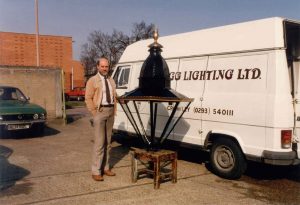
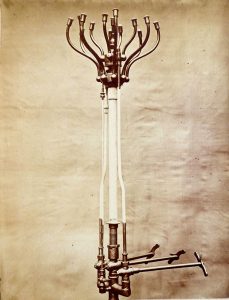
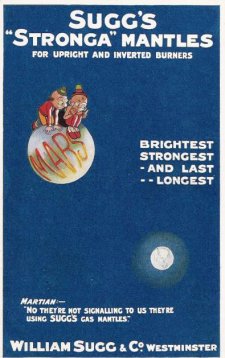
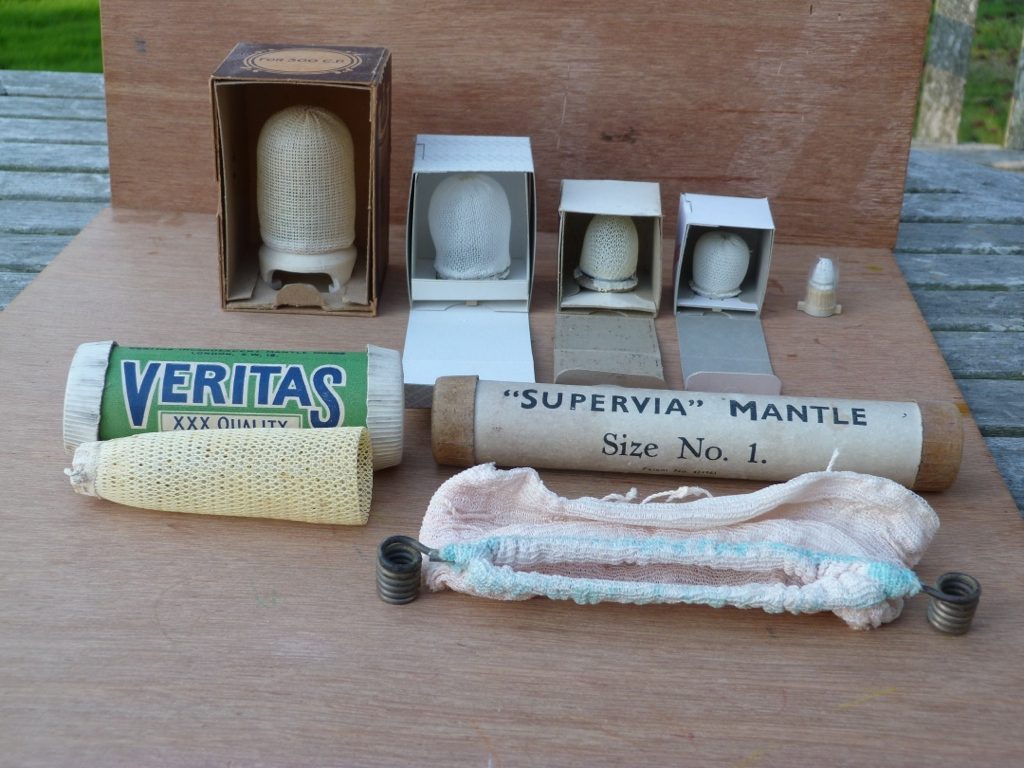
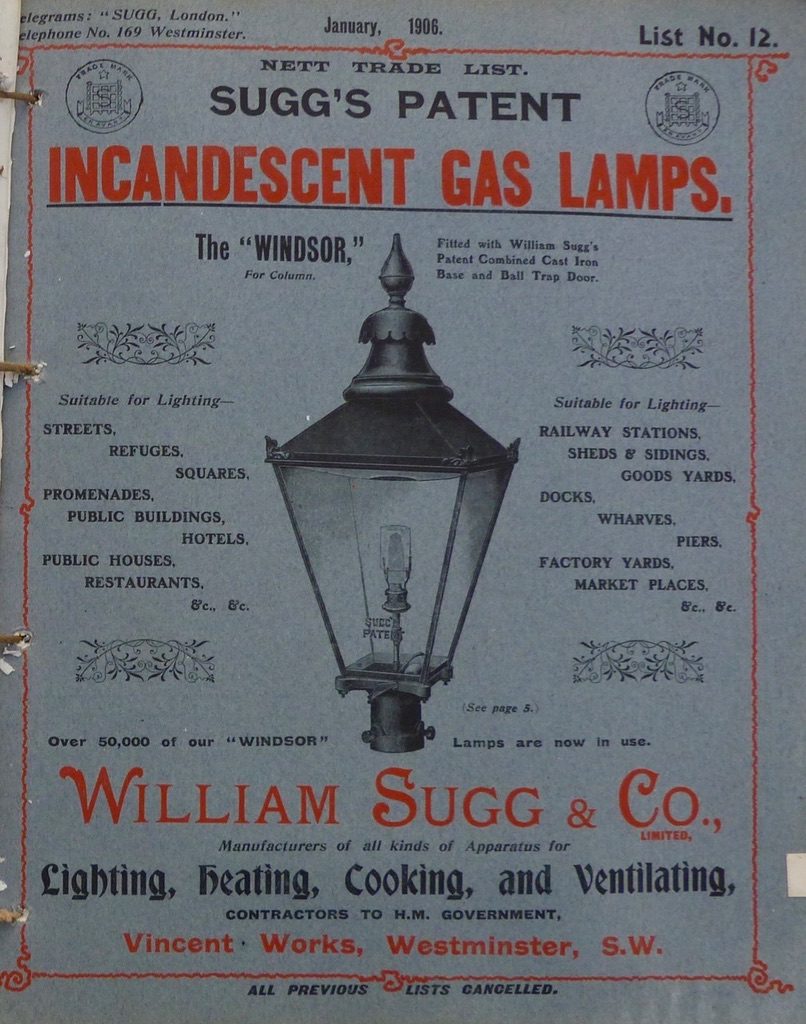
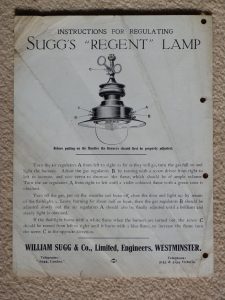
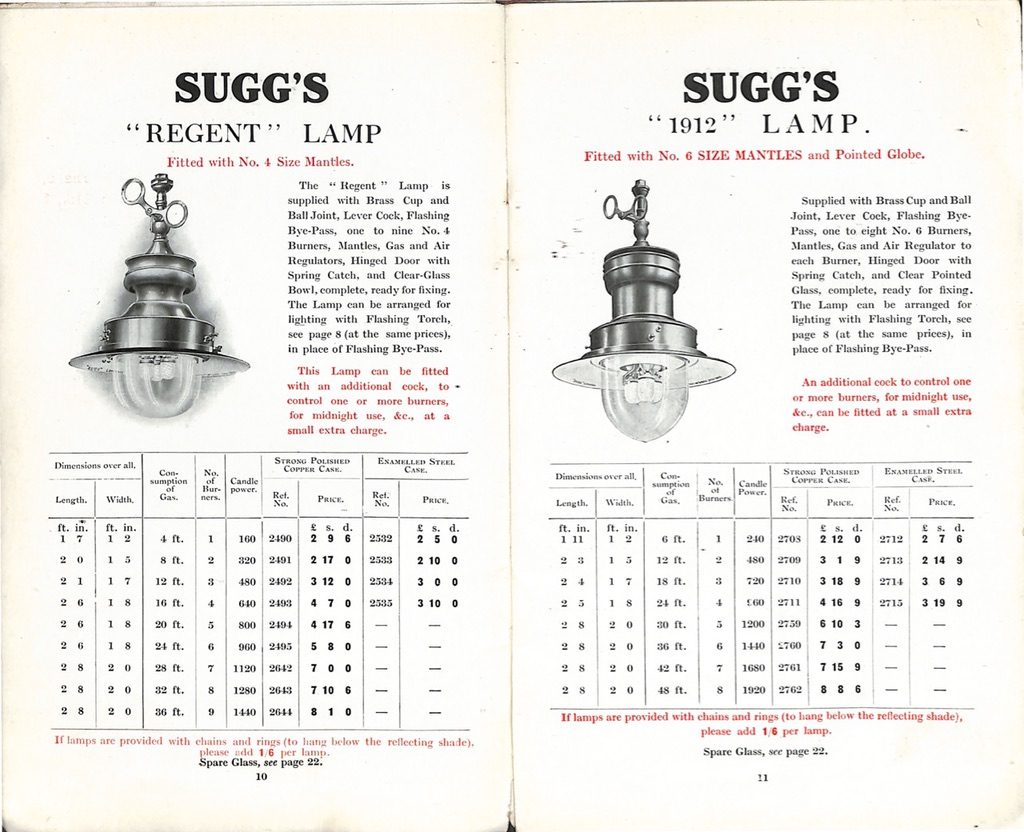

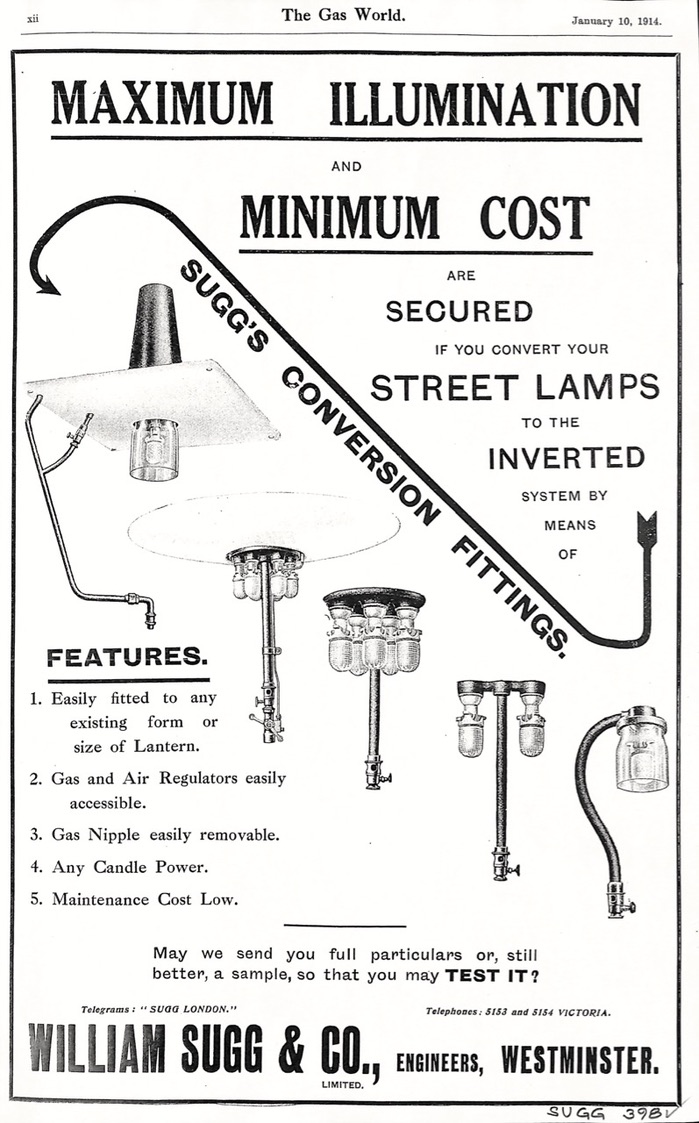
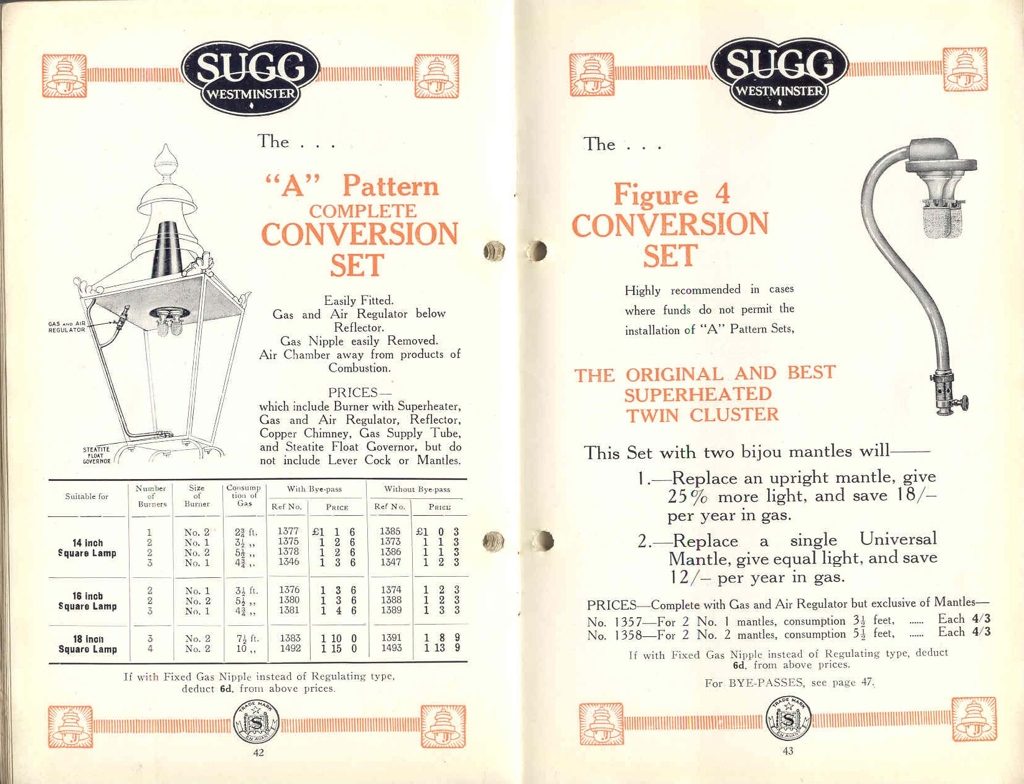

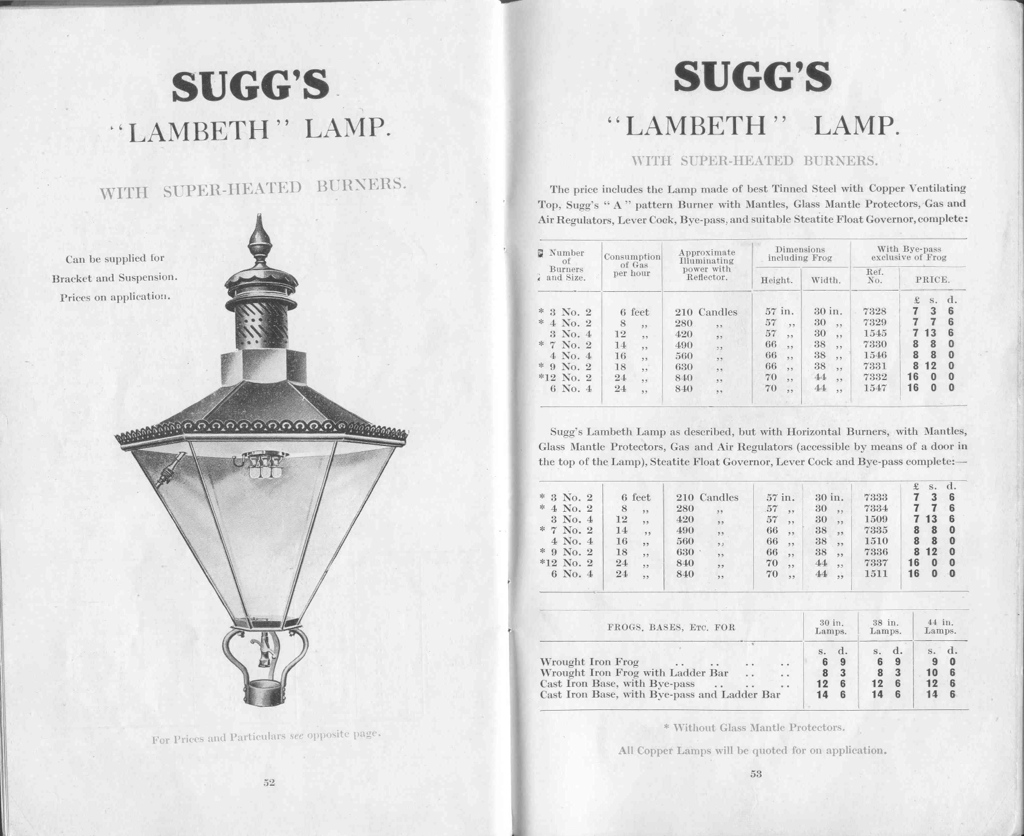
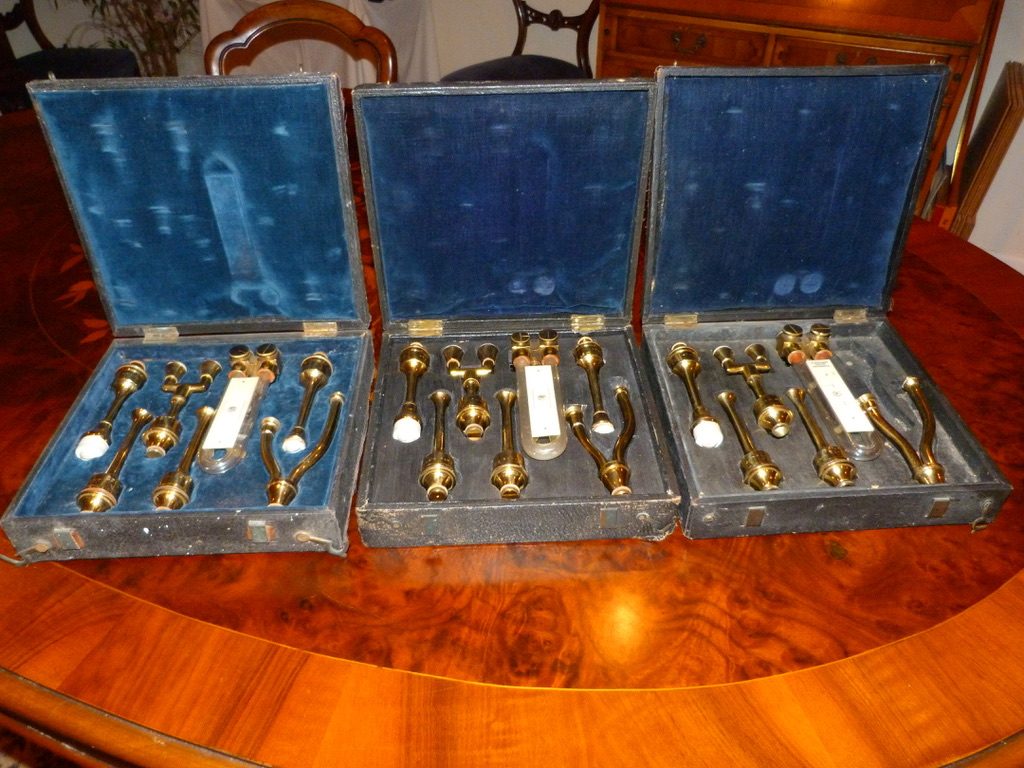
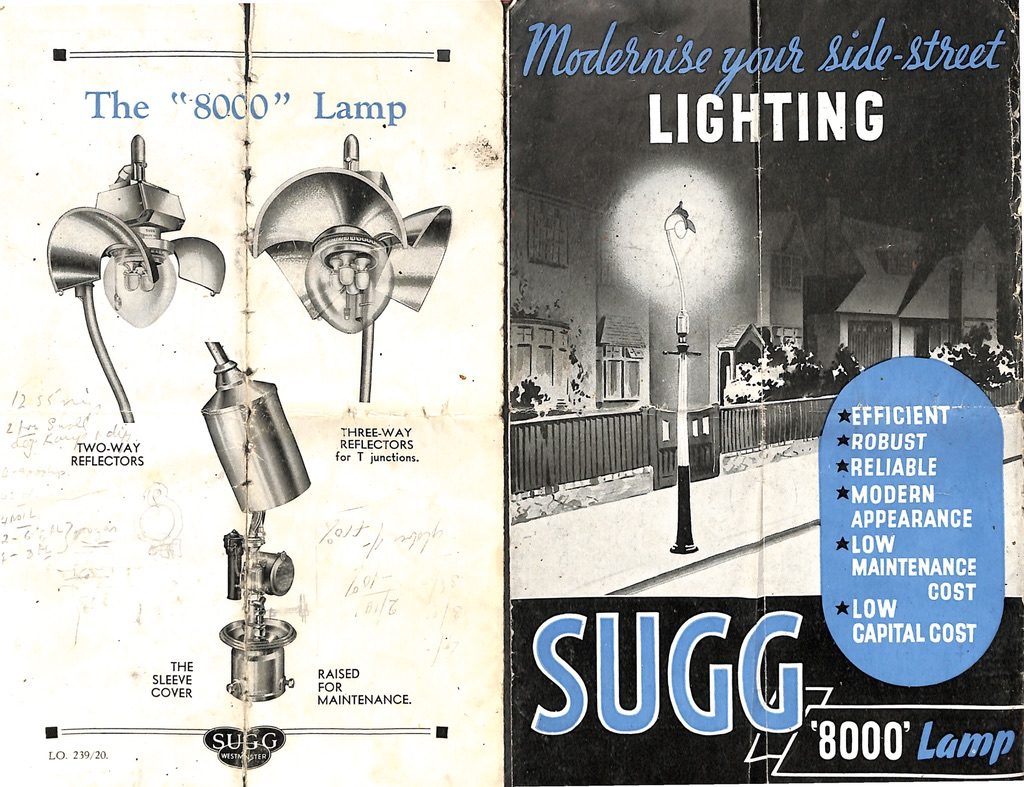

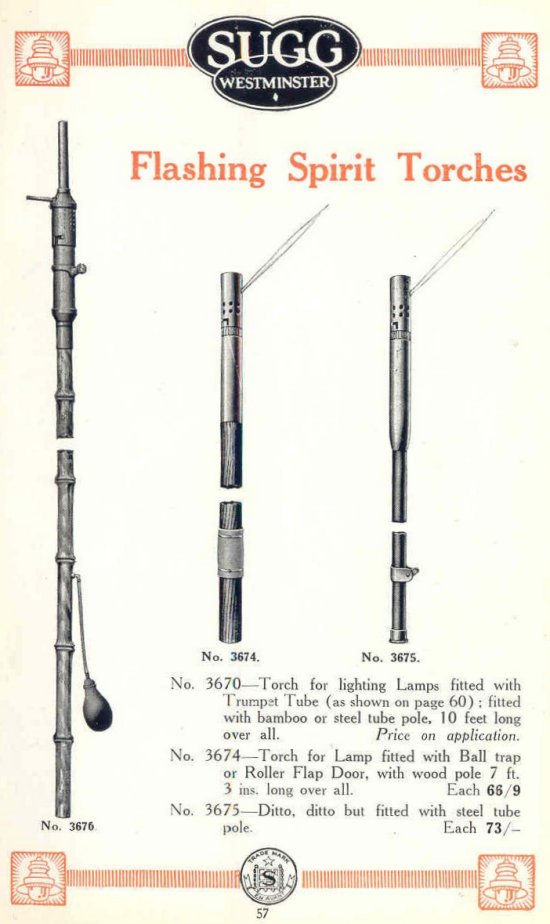
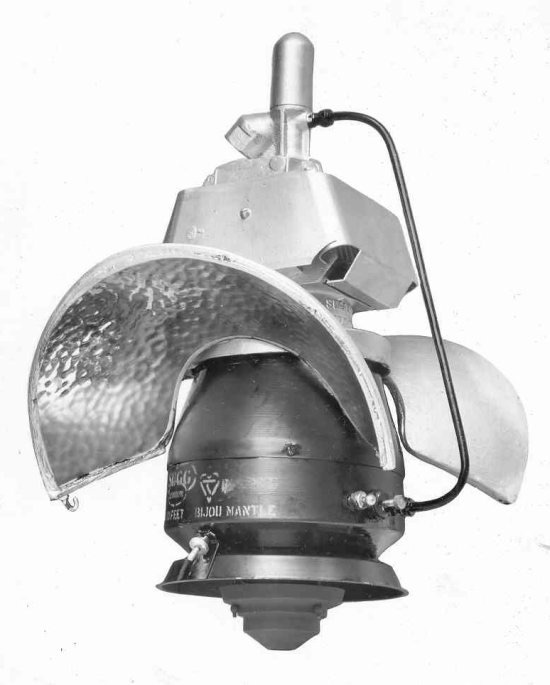
7 responses
Blessings, Mr Sugg , What a well written , interesting and informative piece. I suppose that you being a living scion of William Sugg is responsible, Thank You again!
Good Wishes for the Summer,
RxR
Excellent article Chris,do film makers ever do any research into such details! I have demonstrated bright steady flames with mixtures of Butane, air and hydrogen gas using batswing,slit union and fish tail burners (not Sugg but the rival Bray!) https://youtu.be/ueJUVpD9W_k
Would be great to demonstrate to the wider public to educate them on such matters.
Interesting research into adding hydrogen to the NGas network may even make this easier in the future! https://www.telegraph.co.uk/business/2018/01/06/hydrogen/
regards
Martin
Thank you Martin, your piece of video is a great demonstration of open flame shapes. I think reality is largely ignored against a story-line that the film makers wish to follow! The lamps that were supplied by Sugg Lighting for the film were Windsor lamps that were never supplied with open flames as they were actually the first lamp manufactured for use with the gas mantle, originally upright of course, by William Sugg & Co.
I note that there are several film clips of gas lamps on u-tube.
A sole, token gas lamp is located at N. Holliday Street and E. Baltimore Street as a monument to the first gas lamp in America, erected at that location.
Can you send me a photo. Is this really the first place that had a gas lamp in America?
Thanks for such an interesting site. I understand that my first house (1926-built) had originally been gas lit as electricity didn’t become available in the area until the early 1930’s. All the pipework was still in situ, and during the energy crisis of the 1970’s I seriously considered getting some Sugg gas lamps, but didn’t as things soon got back to normal. I still have the leaflets somewhere in the loft.
Three of my then local London Underground stations (Upton Park, East Ham, and Barking) were all still gas-lit until the 1960’s. Barking went electric when it was modernised in the early 1960’s, but the other two were not converted to electricity until responsibility for the stations were transferred from BR to LT, I think in the early 1970’s. I have a photo of one of the lamps that I took at Upton Park circa 1965: they all had pilot lights.
When I visited Backnang in Germany in the late 1990’s, I found thst the main street of the old town centre was lit by triple-burner gas lamps. They gave quite a bright light. My late father used to work for North Thames Gas at Beckton gas works, so I have always had an interest in gas-related things.
Thank you for your comments and memories. We re-started making gas lamps at the time of the miner’s strike and the 3-day week because a gas light provided both light and heat so even difficult times can result in something positive! When you think of the millions of gas lights that must have been in use it is not surprising that there are still some out there, although there are fewer people these days who would recognise them!
Germany still has thousands of gas street lights and a supportive group of enthusiasts to keep them in place. Chris